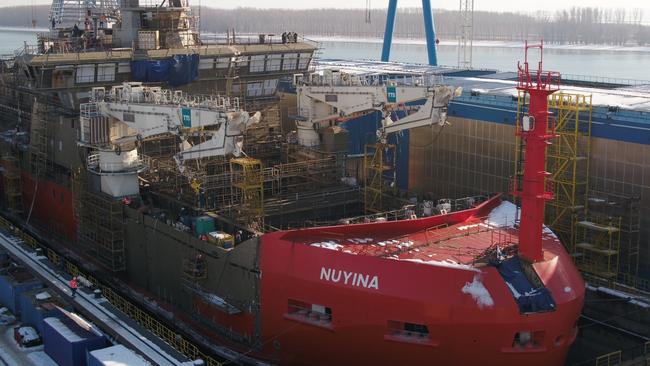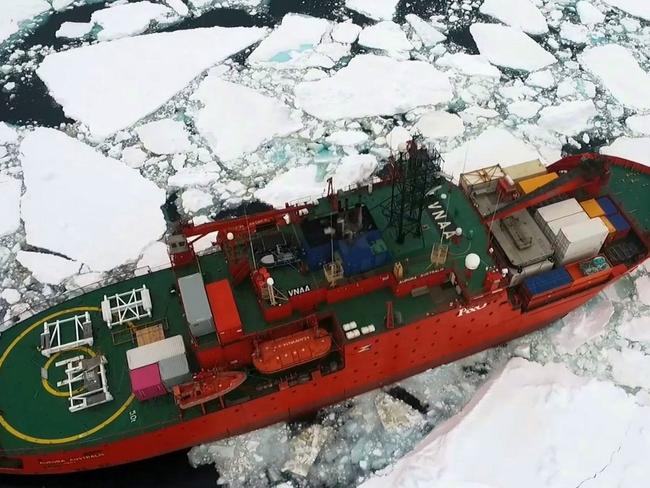State-of-the-art successor to Antarctic workhorse
After 30 years of service, Aurora Australis makes way for a new lifeline.

If worse things happen at sea, as the saying goes, nowhere are they crueller than on the lonely, gale-tormented, ice-infested Southern Ocean. Towering waves pound for days, tossing ships and those imprisoned within like the helpless playthings of an unseen hand. Spirits, if not bones, are broken.
Even Douglas Mawson got seasick, complaining of his ship, SY Aurora, “rolling day and night without ceasing”.
As one nears the frozen continent, a new hazard emerges. Calmer seas freeze before one’s eyes; the surrounding ice, a silent foe, closes in until you are paralysed in its embrace, fearing a Shackleton-like fate.
These are the conditions that must be endured on a regular basis by the men and women and ships that serve as a lifeline, in terms of supplies and personnel, to Australia’s Antarctic and sub-Antarctic stations.
For three decades this extraordinary role has been led by a courageous, bright orange ship built in Newcastle in 1989. Aurora Australis, known affectionately by crew and expeditioners as the Orange Roughy or BOB (Big Orange Boat), has been the backbone of the Australian Antarctic Program. However, it is showing signs of age after 30 years of unrelenting service. Next year, the baton will pass to another vessel.
Australia’s new icebreaker — named Nuyina, an Aboriginal word for aurora australis, or the southern lights, continuing a tradition that stretches back to Mawson — promises to revolutionise the nation’s Antarctic program.
RSV Nuyina, entering its final stages of construction at Damen Shipyards in Galati, Romania, will be bigger, stronger and smarter.
It will allow Australia to do more down south, with extended voyage times, vastly increased reach, endurance and icebreaking ability, cargo capacity, as well as more scientific bells and whistles.
It’s an exciting time for the program which, though focused on science, also underlines Australia’s boast of being a leading Antarctic nation, laying claim to 42 per cent of the continent.
The almost $2 billion investment, combined with an upgrade of our four stations and plans for an inland ice traverse capability, signals a reinvigoration of Australia’s Antarctica engagement.
Others, not least China, are doing likewise at a time of some unease about the long-term future of the planet’s last wilderness.
“The Nuyina is a once-in-a-generation project that will form the centrepiece of Australia’s Antarctic Program for the next 30 years,” says Nick Browne, icebreaker project manager with the Australian Antarctic Division.
“Nuyina will drive Antarctic and Southern Ocean research, sustaining the next generation of Australian Antarctic scientists. It is very difficult not to be excited. She will be one of, if not the most, powerful icebreakers operating in Antarctica. When it comes to combining icebreaking capability into a multipurpose platform capable of supporting scientific research and cargo or logistics functions, the Nuyina will in my view be the world leader.”
For many, though, excitement is tinged with regret at the loss of a ship, in Aurora Australis, that has played such a pivotal role in their lives as well as the nation’s Antarctic endeavours. This is particularly so for those who have worked on the Aurora for a decade or more.
“This ship is another home for me,” says Brad Collins, who supervises the vital, high-risk task of pumping fuel from ship to station during resupply operations. “I’ve spent more time here (on board the Aurora) in the last 10 years than I have at home.”
He hopes to work on Nuyina but will miss Aurora, whose crew must apply for jobs with the new vessel’s operator, Serco Australia.
“There are so many great people, with so much vast knowledge, from so many different walks of life; people you would never bump into in your wildest dreams if you just did your normal day-to-day role back in Australia,” Collins says. “Everyone from glaciologists to atmospheric scientists. I love the camaraderie. The ship sense of community, that’s one of the big attractions.
“The places, too. We’ve been to places no other ships have been to since the first ship sailed around the Antarctic. It’s just magic. It’s definitely not a dull life.”

Collins has been stuck in ice on numerous occasions and was on board in 2016 when Aurora broke from its mooring in a 130km/h blizzard at Mawson Station, running aground on rocks. The first sign of trouble was an announcement on the ship’s PA.
“It was for the engineers to start the main engines ‘immediately’,” he recalls. “I thought there was a little more stress in that voice than you would expect. It was only a minute or two later that we hit the rocks with such force that I almost fell out of my chair.
“They wanted to evacuate immediately but it was too windy. For the majority of people on the ship, the wind would have just blown them away.”
The expeditioners eventually were removed by barge when conditions eased and they were flown out while the crew sailed the damaged Aurora back to Hobart for repairs. Such mishaps are rare but the extremity and volatility of conditions mean ships must be well drilled.
One of the ship’s masters, Gerry O’Doherty, who has worked on the vessel for 20 years, says the toughest part of the job is not necessarily enduring the conditions but rather the heartbreak they can bring.
“You can have 18m-high waves that relentlessly descend upon the ship for days on end, hurricane winds filled with snow and sleet and ice that push the ship into god knows what, heavy ice that can’t be broken, pushed through or escaped,” O’Doherty says.
“They deprive you of sleep, damage the ship, injure the crew and make everyday tasks a real chore. But that’s not what makes a voyage tough. The truly difficult times are when you can’t make your scheduled destination in time, or at all. Then you see first-hand how that circumstance has robbed someone of their chance to obtain the data they were seeking, the PhD they were working toward, the infrastructure project they were contracted to do or the once-in-a-lifetime opportunity to set foot on the Antarctic continent. Feeling the gravity of that disappointment … is what’s really tough.”
Hardships and disappointments are erased, however, by intense and unique moments of wonder: a night sky illuminated by the streaks and surges of the southern lights; a close encounter with a leviathan of the deep such as a humpback whale, or the profound silence and endless expanse of a sea turned to ice.
For O’Doherty it is hard to beat New Year’s Eve 1999: “We were parked up at the Amery Ice Shelf and made a bar and dance floor on the ice alongside the ship. At midnight, while the sun was still in view on the southern horizon, we waltzed to classical music amid a troupe of penguins. Does it sound surreal? It was.”
While tears will be shed for Aurora, whose fate is unclear — owner P&O is searching for a new contract and it may continue to assist AAD during the transition — Browne says Nuyina will be a “game changer”.
Both ships have similar speeds and passenger capacities, but the new flagship, due in Hobart in the middle of next year, comes into its own with range: 30,000 nautical miles compared with Aurora’s 13,000. The number of funded voyage days each year will increase from 180 to 200. Nuyina’s 300 per cent larger cargo capacity and 70 per cent increase in fuel storage will mean essential logistics work is completed in fewer days. This frees up more time to help with station upgrades, visits to Australia’s external territories Heard Island and McDonald Islands, and for important ship-based science.
To that end, Nuyina has a host of improvements to aid marine science, most intriguingly a silent mode, allowing the ship to be powered by two “advanced electric drives” rather than its main diesel engines. It sounds like something from a spy novel but it is aimed solidly at research.
“Lower noise levels being radiated away from the ship … are important for biomass assessment of fish stocks,” Browne says. It also improves the effectiveness of sensitive acoustic equipment in the ship’s hull and drop keels. Breaking the ice will be so much easier.
Rather than Aurora’s repeated ram-raid style, Nuyina’s bow has been designed to bend and slice the ice.
“The specially designed geometry of the bow enables the vessel to ride up on to the ice sheet and to break the ice through flexural or bending failure, by applying a vertical downward force,” Browne says.
“Nuyina will offer around 60 per cent increase in icebreaking performance.”
This will allow the Antarctic season to be extended to shoulder and winter seasons, when ice conditions are heavier.
Antarctica’s fickle, ferocious conditions will continue to test and torment those who venture south. But Australia at least will retain the wherewithal to overcome them for another 30 years.




To join the conversation, please log in. Don't have an account? Register
Join the conversation, you are commenting as Logout